The Reign of Wolf 21
Air Date: Week of August 12, 2022
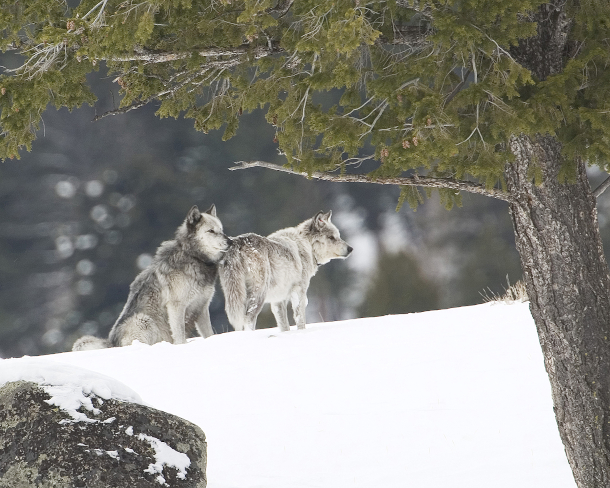
Wolf 21 and Wolf 42 on their last day together. They were nearly nine years old, twice the average life-span of Yellowstone wolves. (Photo: Kim Kaiser)
Wolf expert Rick McIntyre’s 2020 book "The Reign of Wolf 21" is the true love story of an alpha pair who lead their Yellowstone pack with grace, courage, and an unbreakable bond. Living on Earth’s Jenni Doering has the story of these remarkable wolves’ lives and what they can teach us about love, loyalty, and leadership.
Transcript
CURWOOD: It’s Living on Earth I’m Steve Curwood.
DOERING: And I’m Jenni Doering.
One of the most endearing aspects of dogs as pets is they can respond to each other and us humans with what seems to be unconditional love. So we shouldn’t be surprised by a love story about two wolves, given that wolves and dogs have almost identical DNA. I learned the wolf love story you are about to hear from Rick McIntyre who logged more than 100,000 wolf sightings in Yellowstone National Park as a biological technician with the Yellowstone Wolf Project. Rick’s longest continuous streak of watching the wolves starting in June 2000 was an incredible six thousand, one hundred seventy-five days. Wolves are most active at dusk and dawn, so Rick had lot of early mornings and late nights. And cold, sometimes the temperature got as low as 33 below! Rick McIntyre is retired now but he still gets out into the field almost every morning to watch the wolves, before coming home to write about them. I spoke with him about his 2020 book “The Reign of Wolf 21” which is the heartfelt account of 21 and his mate 42, and the Druid wolf pack they led for a decade in Yellowstone National Park.
[Paul Winter, “Wolf Eyes” on Common Ground, A&M Records]
DOERING: When Rick McIntyre is out tracking wolves, he peers down a powerful spotting scope to see them as far as a mile away. And shares the view with visitors.
MCINTYRE: A lot of folks visit Yellowstone; they all want to see wolves, so folks like myself, we get to help people have an experience with that. I’ve shown famous people wolves, movie stars; politicians; I’ve shown regular people, I’ve shown schoolkids…
DOERING: And he does a lot of his wolf watching in the Lamar Valley as its wide, flat meadows attract large herds of elk, pronghorn, and bison.
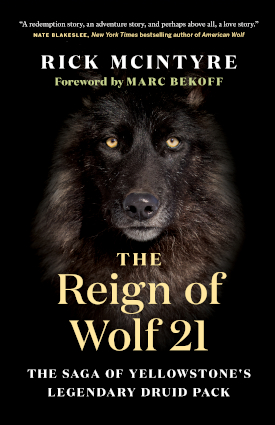
The Reign of Wolf 21 is part of Rick McIntyre’s “Alpha Wolves of Yellowstone” series. (Image: courtesy of Greystone Books)
[SOUNDS OF BISON GRAZING IN LAMAR VALLEY]
DOERING: Several creeks feed the Lamar River braiding its way beneath the snow-capped Absarokas. It’s a big, open landscape where humans can feel like there’s so much beyond us.
MCINTYRE: I think we understand now that we’re just part of a very big world and many other species are out there, including primates, and wolves, dolphins, whales, etc that have emotions and intelligence that are very very similar to us. Anyone that watches wolves in the wild, there’s just no way around it that they have very strong emotional aspects of their lives; they’re rational thinkers; they make decisions, whether good or bad.
DOERING: And they’re highly social animals who live together in packs of five to ten members. And Rick says packs can briefly grow to 30 or more members before some strike out on their own, living life as a lone wolf before finding another home.
[WOLF CALLS]
DOERING: And he told me he had to write a book about the alpha male that researchers called Wolf 21.
MCINTYRE: Well, there’s so much to say about him, it's almost like if Superman was a real person, how could you describe him?
[Paul Winter, “Wolf Eyes” on Common Ground, A&M Records]
DOERING: This hero had mostly grey fur, with a cape of black along his back. He not only survived in the harsh Yellowstone climate… As the alpha male of the powerful Druid Peak Pack, Wolf 21 thrived.
MCINTYRE: So from his biological father who he never knew, 21 was gifted with extremely superior genetics. So he grew up into a very large, a very strong wolf.
DOERING: Which matters a lot when it’s your responsibility to bring down elk and even bison. And to protect your family from rival packs. The Yellowstone ecosystem supports about 8 to 10 packs with names like Leopold, Chief Joseph and Mollie’s, which each patrol their own territory. They often overlap, and conflicts are common. In fact, wolves in Yellowstone are most likely to die from wounds inflicted by other wolves. But Wolf 21 didn’t have to worry too much about that.
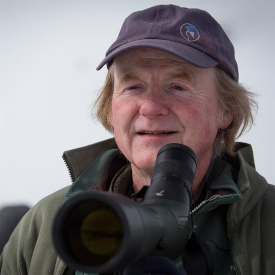
Rick McIntyre with his powerful spotting scope, which he uses to help him see wolves as far as a mile away. (Photo: Julie Argyle)
MCINTYRE: As far as we know, he never lost a fight in his life, including times where he had to fight several other males at the same time, so he was the undisputed undefeated heavyweight champion of Yellowstone.
DOERING: And, despite the fact that wolf fights can be brutal…
MCINTYRE: He never killed a defeated opponent.
DOERING: He’d beat up rival wolves, sure. Fearlessly defend his kin. He let rival packs know whose land they were on, the mighty Druids. But then he’d step back and let them go.
[Paul Winter, “Wolf Eyes” on Common Ground, A&M Records]
MCINTYRE: He was, um… I think many people would agree that he was probably the greatest wolf that has ever been known by a human being, so just to be able to see him every day for year after year was just a huge privilege on my part. I saw him deal with all sorts of problems and crises, and he just had this very smooth way of mainly using nonviolence when he could, or minimum violence and force when necessary. Oftentimes I would compare him to people who had very special dogs in their life, that were so loyal and devoted and had such good characters, and I think you know that all modern dogs in the world come directly from wolf ancestors, so everything we admire in our pet dogs, their courage, their bravery, their loyalty, their devotion, their playfulness, all that, that comes exactly from ancestors like Wolf 21.
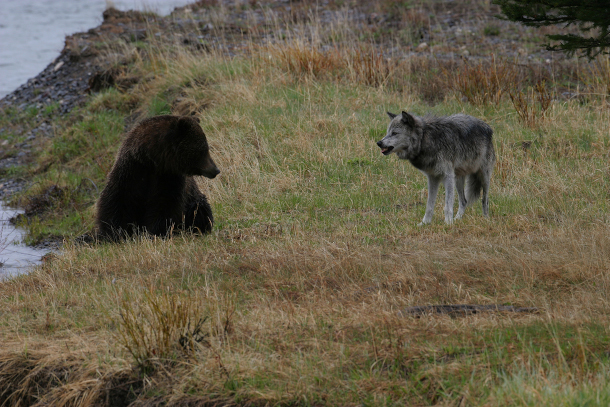
Wolf 21 confronts a grizzly bear eyeing an elk the alpha wolf had just killed. (Photo: Betsy Downey)
[Paul Winter, “Wolf Eyes” on Common Ground, A&M Records]
DOERING: Alongside the alpha female, he led one of the largest packs in Yellowstone history, with 37 wolves at its height. The Druid Pack drew the fervent attention of the wolf watching public. They’d flock in the hundreds to the Lamar Valley where they reigned. Rick would help them find the pack, and if they were lucky and patient, these adoring Yellowstone visitors would get to see the alphas leading a hunt or chowing down on a carcass… or playing with their pups.
[SOUNDS OF WOLF PUPS PLAYING AND ADULT GROWLING]
MCINTYRE: You would see this gigantic male wolf start a wrestling match with a little tiny pup, let’s say, maybe a month or two old.
[WOLF PUP PLAYING SFX]
MCINTYRE: And it seemed like 21 would wait for the pup to grab one of 21’s legs or maybe a piece of fur on his belly or something like that. And with the most gentle tug that probably the pup was making, 21 would flop over on his back, pretending that the little pup had just defeated him in battle. It was just another aspect of his personality that was so fascinating to watch.
DOERING: The alpha male Wolf 21 was beloved by the public and it’s no surprise he’s the focus of Rick’s book. But Rick says the alpha female plays just as important of a role, if not more so, in leading the pack. And at one point in the Druid Peak Pack, the alpha female known as Wolf 40 had a leadership style that, well let’s just say it was very different from Wolf 21’s peaceful demeanor.
[SOUNDS OF WOLF SNARLS, GROWLS, YELPS]
DOERING: Competition within packs is normal; after all – the alphas have the best chance of passing on their genes, and there can only be one alpha male, and one alpha female. And sometimes, she’ll do anything to gain power.
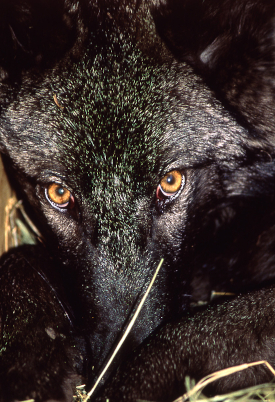
Wolf 21 at 5 months old. His pack was relocated to an acclimation pen after the alpha male, 21’s father, was shot and killed just outside of the Yellowstone National Park boundary. (Photo: NPS / Barry O’Neill)
MCINTYRE: We don't know exactly what 40’s problem was, but she had a very violent and aggressive personality. She drove her own mother out of the pack, and then one of her two sisters, so that she was now the alpha female.
DOERING: For years, she relentlessly bullied and abused her remaining sister, who didn’t seem to be able to fight back.
[SOUNDS OF WOLF SNARLS, GROWLS, YELPS]
DOERING: She’d bite and beat up “Cinderella”, which is what the Wolf Project researchers nicknamed the underdog. There were signs that the old alpha even killed her sister’s pups two years in a row, in 1998 and ‘99. A wolf pack can only feed so many hungry mouths, so this kind of behavior isn’t unusual, though it sounds cruel. And the big, powerful Wolf 21?...
MCINTYRE: Male wolves in the wild seem to have a compunction against doing anything that will harm a female.
DOERING: … He could only stand helplessly aside as the aggressive female attacked their pack. Then, in 2000, something happened that changed his destiny and the fate of the Druid Peak Pack. The wolves ended up having four litters that spring. That meant a lot of hungry mouths to feed. And “Cinderella” had her pups in a den a few miles away from her abusive sister. One night in May, the alpha female, Wolf 40, decided she didn’t want to put up with competition from her sister 42’s young pups.
[SOUNDS OF WOLF SNARLS, GROWLS, YELPS]
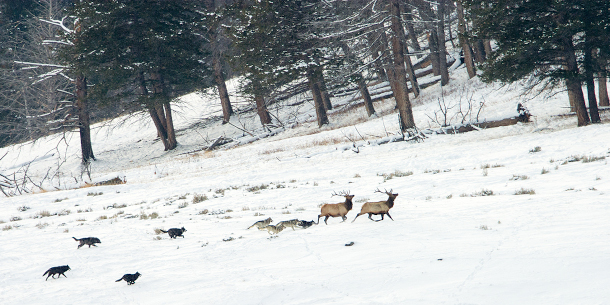
The Druid Peak Pack chasing bull elk in Yellowstone. (Photo: Doug Dance)
MCINTYRE: As far as we can tell, for the first time in her life, 42 actually stood up to her sister. She had to, to protect her pups, and in a fight with her sister 42 could not win, she just did not have the killer instinct.
DOERING: But some younger females in the pack had been bullied too, and they came to her aid.
MCINTYRE: So when I came out early the next morning, I found wolf 40 lying next to the road just drenched in blood, covered with wolf bites. And she died of blood loss just a short time after that. So all those years of abuse that 42 had suffered from her sister, it culminated that night.
[SOUNDS OF GROUP HOWLS]
DOERING: And “Cinderella” became the new alpha female of the Druid Peak Pack.
[GROUP HOWLS]
DOERING: Now she and Wolf 21 reigned over the grand Lamar Valley.
[Paul Winter, “Wolf Eyes” on Common Ground, A&M Records]
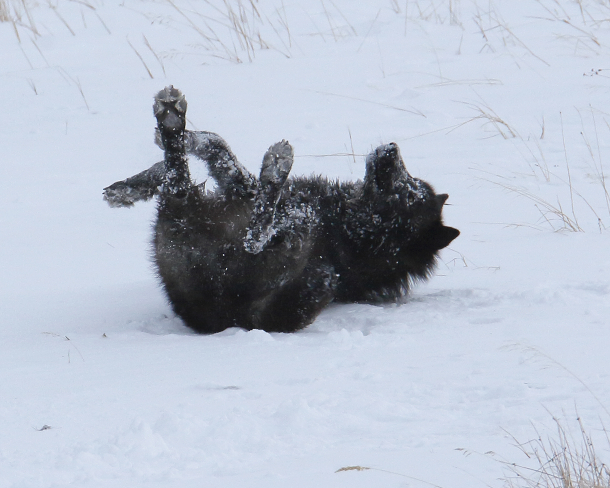
A Druid pup scratches its back by rolling on the snow. (Photo: Bob Weselmann)
DOERING: They had a strong pair bond and seemed meant for each other, Rick says.
MCINTYRE: It really was a special thing. They spent at least two thirds of their life together. They were devoted to each other.
[Paul Winter, “Wolf Eyes” on Common Ground, A&M Records]
DOERING: It was a bond that knit them tighter together with time.
MCINTYRE: They were both born with jet-black fur, and as sometimes happens with married couples that are together for decades and decades, as they grew old they looked even more and more like each other, so they started to turn grey about the same pattern.
[Paul Winter, “Wolf Eyes” on Common Ground, A&M Records]
DOERING: Every morning, Rick rose at 3:30 or so to get out in the field and watch their lives unfold. To see what he could learn from the behavior of the alpha male and the many litters he raised with 42.
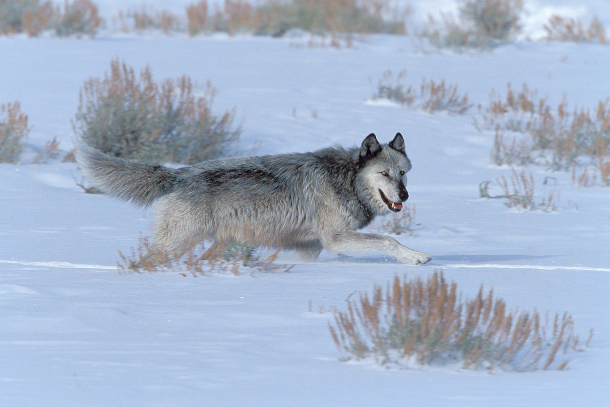
Wolf 21 at age eight with a lot of gray on his black coat. (Photo: Doug Dance)
MCINTYRE: He was so dedicated to his family, to his friends, he would do anything for them. Certainly, risk his life constantly for them.
DOERING: Even provide emotional support.
MCINTYRE: Especially with the younger wolves in his family. There was a time where he noticed that one of his young sons was being bullied by the other yearlings, and 21 went out of his way to go to that one particular yearling and give him special attention in front of the other young males.
DOERING: And if you’re a young wolf in a pack and the alpha male comes over to you –
MCINTYRE: -- and gives you special attention like he approves of you, that’s a pretty big deal.
[Paul Winter, “Wolf Eyes” on Common Ground, A&M Records]
DOERING: Rick says this kindness and empathy made Wolf 21 stand out.
MCINTYRE: He certainly was an ideal role model for me, and for everyone else that knew him. If all of us could be more like 21, or like 42, the world would be a lot better place.
[Paul Winter, “Wolf Eyes” on Common Ground, A&M Records]
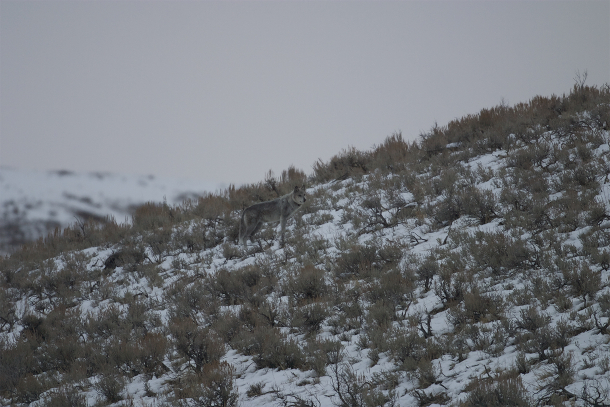
Alpha female Wolf 42, longtime mate to 21, when she was eight years old. (Photo: Steven Hargreaves)
MCINTYRE: So this one particular day in late January I saw the two of them come together, it was just the start of the mating season, and they were very affectionate with each other and from a distance of about a mile or two away, I saw them have a mating.
It was very touching, because they laid down as they were still mating, and he put one of his paws around her shoulder in a very affectionate way.
[Paul Winter, “Wolf Eyes” on Common Ground, A&M Records]
DOERING: The next morning Rick got up as usual hours before sunrise and soon spotted the family. He could see the patriarch. But where was his mate?
He couldn’t get a signal from her radio collar.
“Cinderella” was missing.
Rick and his colleagues started searching for her.
MCINTYRE: We found out what happened to her that night.
DOERING: The wolf project tracking plane circled over where it looked like there had been a big fight. The alpha female lay still in the snow, the latest victim of a wolf battle, with the rival Mollie’s Pack.
MCINTYRE: But 21 did not know.
[SOUNDS OF MOURNFUL WOLF HOWL]
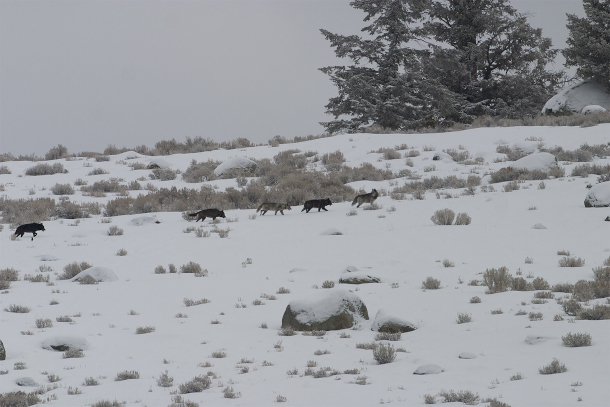
The Druid pack (Photo: Steven Hargreaves)
DOERING: He spent the next two months going in a search pattern throughout his territory, as far as I could tell, acting like he was trying to find her. And he never did.
[SOUNDS OF HOWLS AND WIND]
MCINTYRE: And I could see that he was rapidly experiencing a physical decline. He was turning gray at a much faster rate than he had just a short time before that. He seemed to be listless. He just wasn't the same as he had been prior to that time.
DOERING: Before long, 4 months had passed since she had gone missing. It was June now, nearly the longest day of the year. Rick was up early as usual, watching the pack.
MCINTYRE: And some of the younger adults in the family had a few elk come into their meadow.
DOERING: The young Druids eagerly gave chase, but…
MCINTYRE: I looked over at 21, and he just was lying there, he just had no energy left to join in that hunt. And that was the moment that I realized that this was really about it for 21, that this was so unlike him. And that was the last time I saw him.
DOERING: A month passed with no sign of what had happened to the old alpha male. Then, in mid-July, a grim discovery. An outfitter found wolf remains with a radio collar that had long since stopped working. Rick and a pack of other Wolf Project and park employees rode on horseback up to the meadow where he had been found.
DOERING: It had been a special rendezvous site for the Druid Alphas, a place to meet up.
[Paul Winter, “Wolf Eyes” on Common Ground, A&M Records]
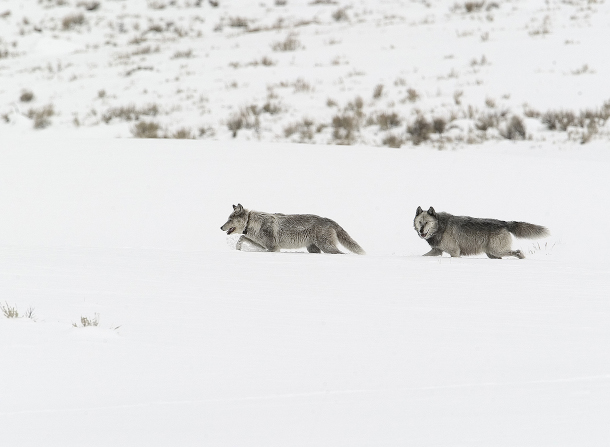
Wolf 21 and 42 on the move, on their last day together (Photo: Kim Kaiser))
MCINTYRE: He decided to go one last place, way up in the mountains. One last place where there might be a chance of finding 42.
DOERING: She wasn’t there, but a tree they’d marked together many times might have held a trace of her scent. He’d curled up and gone to sleep one last time in the shade of that tree, maybe dreaming of his long-lost love.
[Paul Winter, “Wolf Eyes” on Common Ground, A&M Records]
DOERING: Rick McIntyre’s 2020 book is called The Reign of Wolf 21.
Links
Find the book "The Reign of Wolf 21" (Affiliate link helps donate to LOE and local indie bookstores)
Learn more about the Yellowstone Wolf Project
Living on Earth wants to hear from you!
Living on Earth
62 Calef Highway, Suite 212
Lee, NH 03861
Telephone: 617-287-4121
E-mail: comments@loe.org
Newsletter [Click here]
Donate to Living on Earth!
Living on Earth is an independent media program and relies entirely on contributions from listeners and institutions supporting public service. Please donate now to preserve an independent environmental voice.
NewsletterLiving on Earth offers a weekly delivery of the show's rundown to your mailbox. Sign up for our newsletter today!
 Sailors For The Sea: Be the change you want to sea.
Sailors For The Sea: Be the change you want to sea.
 The Grantham Foundation for the Protection of the Environment: Committed to protecting and improving the health of the global environment.
The Grantham Foundation for the Protection of the Environment: Committed to protecting and improving the health of the global environment.
 Contribute to Living on Earth and receive, as our gift to you, an archival print of one of Mark Seth Lender's extraordinary wildlife photographs. Follow the link to see Mark's current collection of photographs.
Contribute to Living on Earth and receive, as our gift to you, an archival print of one of Mark Seth Lender's extraordinary wildlife photographs. Follow the link to see Mark's current collection of photographs.
 Buy a signed copy of Mark Seth Lender's book Smeagull the Seagull & support Living on Earth
Buy a signed copy of Mark Seth Lender's book Smeagull the Seagull & support Living on Earth

